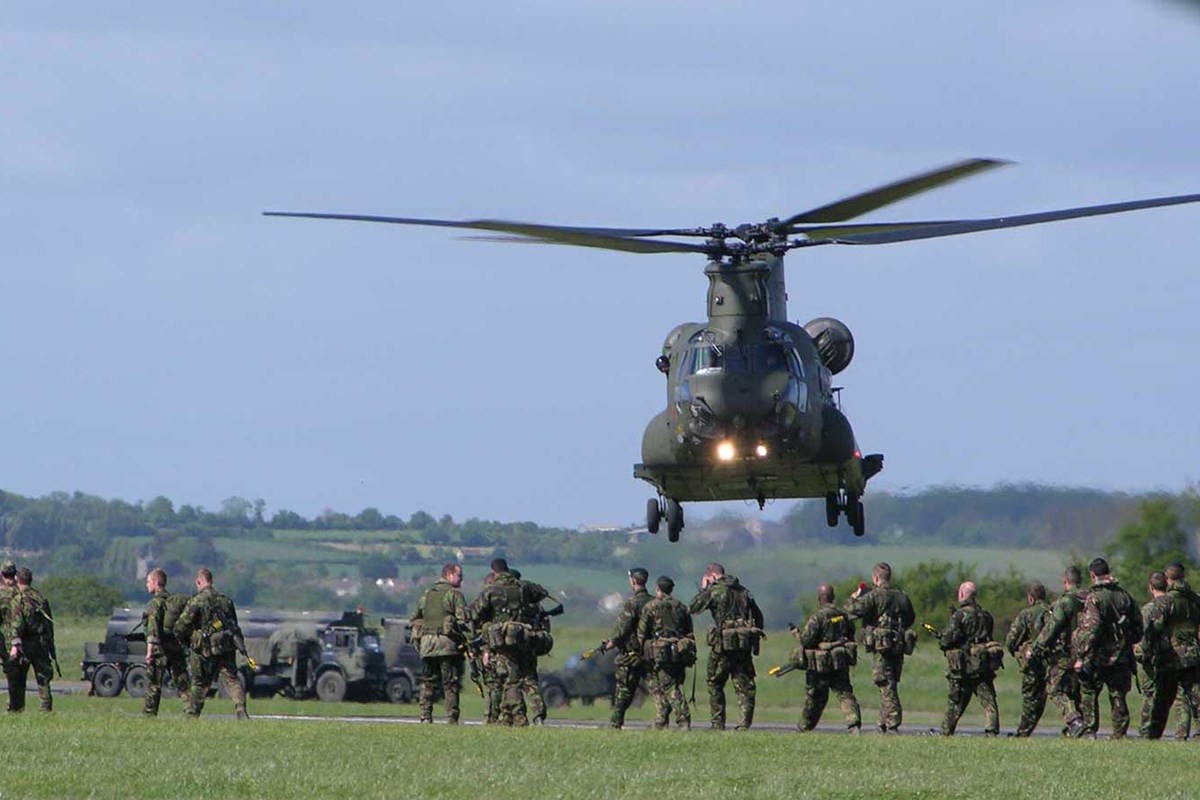
ACANS and the UK Military
30 July 2021"It was Whaley Bridge that proved the tipping point for us" recalls Wing Commander John Coles, RAF Liaison Officer (RAFLO) to the Civil Authority in the South West of England. Wing Commander Coles, known universally as 'Pez' within the Chinook community, was stood next to his contemporary RAFLO from the North of England, Wg Cdr Gary Lane, watching a Chinook from RAF Odiham deliver bags of aggregate to shore up the dam above the village of Whaley Bridge, in Derbyshire. Severe rains had caused damage to the dam, and the village was evacuated over fears the dam may give way, causing significant damage and a genuine risk to life.
"It threatened to turn into something of a circus" Pez recalls, "we had the Chinook working flat out to lift tons of aggregate, which had to be placed accurately, we had to work out where the best place to load up, to refuel and to rest were, and then we had the added complication of other support helicopters from the Emergency Services, such as NPAS and HEMS, civil helicopters we'd hired to assist with liaison tasks, news helicopters and all manner of Unmanned Air Vehicles all trying to get their 'shot' for news or social media - or just out of curiosity. Then, of course, we had the Prime Minister arrive to inspect what was going on - there were aircraft everywhere and no means of controlling them all, nor of them being assured they wouldn't interfere with each other. It certainly gave us cause for concern'.
The RAFLOs instinctively knew that something must be done; Coles admits that afterwards they realised they'd 'got away with it' without embarrassment, or worse. They were impressed by the use of ACANS by the NPAS and HEMS helicopters, and by the power that the MOSIAC ground based equivalent gave to the Emergency Service commanders. At a stroke, the 'Silver' and 'Bronze' commanders could see where all their assets were on a representative map; they could communicate with them via messages and send and receive pictures. "We watched enviously as they could use an Apple Pencil to annotate and mark up maps and photos - it enabled unambiguous information to be shared rapidly across the network" Coles notes. He likened the 'chat' functionality to the ubiquitous use of 'mIRC Chat' windows during the conflicts in Iraq and Afghanistan where many veterans, only half-jokingly, suggest the war was really planned, directed and executed; by relatively junior staff 'chatting' to each other rather than formal orders being cut. It was time for the RAFLOs to join the ACANS 'club'. Calls were made and a small number of ACANS licences made available to the RAFLOs and, to much relief, to the Chinook National Standby crew - who are available 24/7, 365 days per year.
"it's a no-brainer to have the very high readiness Chinook standby crew equipped with ACANS", continued Coles, "the vast majority of standby call-outs are to provide some form of Military Aid to the Civil Authority, such as what we accomplished at Whaley Bridge and the shoring up of the flood bank to protect the village of Wainfleet in Lincolnshire, or to support some form of natural or manmade disaster. Historical examples are the Search and Rescue and recovery efforts after the Boscastle floods, or the aftermath of the Lockerbie or Air India airline tragedies. The Chinook is there to move people and equipment - often these people are Emergency Services and First Responders, the very same people who all use ACANS and/or MOSAIC." Since the retirement of the Sea King helicopters of the RAF/RN Search and Rescue Force, there has been no regular military helicopter equipped to talk directly to the Police or Fire Service via their in-house role radios. "From a national resilience perspective, that was a considerable capability gap" according to Coles, "the Sea Kings had an Airwave radio system to provide a basic level of communications, but it was always a bit ad hoc".
The RAFLOs have a surprisingly wide remit. They are focal points for liaison, as the title suggests, with Regional Government, local resilience forums, local authorities, and the Emergency Services. Perhaps less well known, they have local responsibility on behalf of the Nuclear Emergency Response Organisation, for Military Home Defence and a plethora of other tasks, including Aircraft Post-Crash Management. The latter occurred on Pez's 'patch' in the South West in March 2021. A Hawk jet trainer from 736 Naval Air Squadron crashed into a field near Helston after a suspected engine problem. Both occupants were able to eject safely, and Police, HEMS, Rescue, and military helicopters all flew to the crash site. "I could tell exactly where the Hawk crashed", recalls Coles, "I could see all of the tracks of the civil helicopters on my ACANS tablet - in fact, I realised I probably had better Situational Awareness than the Operations team at RNAS Culdrose, where the aircraft was based. I called Culdrose Operations and was able to tell them where the crash site was and update them as to the location of civil assets in the vicinity. It enabled the crash site to be swiftly cordoned off, which is vital to preserve evidence for the inevitable enquiry. In the Post Accident review, Culdrose decided to buy their own ACANS licences and Tablets to improve their Situational Awareness for day-to-day operations, as well as emergency situations like the crash".
The real driver for the military use of ACANS was the Covid-19 Pandemic. Coles recalls that at the start of the crisis, in March/April 2020, there was significant confusion, and no little concern, over how suspected Covid-19 cases were going to be moved to treatment centres. Coles points out that "You have to remember that at the start of the Pandemic we had no reliable means of testing potential Covid cases. People would get ill, with some or all of the recognisable symptoms, and deteriorate rapidly. In some of the more remote locations in the UK, the local primary care facilities were simply not able to provide the necessary treatment. I got a call from the hospital in the Scilly Isles asking for a helicopter to move a suspected Covid patient to a hospital on the mainland. The 'normal' HEMS helicopter was considered too small in terms of cabin space to permit enough air to circulate, so a Chinook was needed. I had very little detail on the casualty, the airfield, or the aircraft. I got hold of a Chinook, and moved the patient, but the lack of Situational Awareness I had, not being able to track the aircraft on ACANS, brought it home to me how useful it might be during the Pandemic". Coles then went on the describe the 'night and day' difference of a similar mission after ACANS was made available. This time, the seriously ill patient was being transferred from Jersey to a specialist unit in Southampton. From the ACANS display on his iPad, Coles could watch the Chinook lift from Odiham, fly to Jersey (with, he acknowledges, a small 'gap' due to the 4G network limitations over water), then deliver the patient to the hospital before recovering to land at Odiham. He described the Situational Awareness ACANS gave him as 'phenomenal'.
This was a view shared by an increasing number of senior commanders in the MoD. The creation of the Covid-19 Aviation task Force (ATF) was the catalyst for a sharp increase in the use of ACANS by the military. It was clear from the outset that there would be military, NPAS, HEMS and leased civil helicopters all flying in and out of medical facilities - increasing the likelihood of an airprox, or, in the worst case a collision. The Station Commander at RAF Benson, who's Pumas were deployed to remote areas of Scotland, fully endorsed the purchase of ACANS licences. Coles recalls that it was as much about flight following aircraft in sparsely populated areas as it was Command and Control. "It gave the commanders the ability to glance at a screen and see where their aircraft were". They could then be reassured that all was well, and the aircraft and crews were safe and 'on plan'. Decisions over 'who went where' were made easier, and there was an additional benefit that the 4G network enabled aircraft to 'see' each other via ACANS even if not line of sight - helping aircraft in hilly terrain to not be surprised by 'seeing' another asset with ACANS in the next valley - in some respects, a better collision avoidance system than TCAS or ADS-B as it could generate more notice at lower levels. Coles went on to explain how it made the job of designating a suitable landing site so much easier, "Once the crews had ACANS I could take a screenshot of the satellite image, or of the mapping at the appropriate scale. Using the iPad & Apple Pencil, I would annotate the images with safe approach lanes, known obstacles and avoids and other useful information, such as direction range to nearest fuel or the ETA of other assets. I could then send it direct to the aircraft and, importantly, get acknowledgement that they had received it, and answer any questions they may have - changing the plan if needed. It was like doing the whole, fraught and complex, tabletop conditions check and briefing for an Afghan assault mission whilst sipping a coffee in the 'capacity seat'...".
ACANS has proved its worth recently helping planners such as Pez to control the skies around the G7 summit, held at the Carbis Bay Hotel, near St Ives in Cornwall during June 2021. Pez recalls the intensity of the planning surrounding the security arrangements for the seven world leaders of the G&, and the four 'invited guest' leaders. For the UK Police, MoD and other security agencies it was a major event and the sequencing of moving delegates, support staff and their security details was complex and challenging. For Coles, much of this complexity was simplified by having access to MOSAIC/ACANS. "Clearly, not every multinational agency was using ACANS / MOSIAC, but all of the key UK users were, and they could input the movements of 3rd parties if they needed to" he recalls, and, given the attractive target that the conference presented, the position update tool enabled commanders to use it as a 'Blue Force Tracker'. 'This was really helpful; if reports of a vehicle or group of people came in from a 3rd party source, we could quickly determine if they were 'ours' or not, simply by looking at the iPad." Carrying ACANS was mandated for all aircraft and helicopters operating inside the Restricted Area around the conference. Police/HEMS aircraft were already equipped, and the MoD made sure that all Chinook, Puma and Wildcat helicopters assigned to support roles were on the network. The local charter helicopter operator, Castle Air, was contracted to support the summit, and they too had ACANS fitted. "For security reasons, we had a dedicated server for all the ACANS users 'on task' at the G7" notes Coles, "we ensured that any Police drones were put on it for Situational Awareness. The only organisation that didn't use ACANS was the US Presidential Unit, HMX-1 - but as we had UK assets to 'ride along' with them it wasn't a significant issue". He recalled that the weather was less than ideal for the summit, but the SA provided to all crews by ACANS significantly mitigated the risk.
What really stood out to Coles was how quiet the radio frequencies were. He remembered similar events in the past where the voice circuits were clogged with crews making arrival/departure and 'Ops Normal' calls. "There was simply no need - everyone could see everybody on ACANS, and the chat facility enabled messaging back and forth'. He suggests that if an incident had happened, a clear radio net would have been vital for immediate comms - ACANS was therefore adding additional resilience. He posed the rhetorical question many old Support Helicopter crews have when they become aware of ACANS' abilities, "How useful would this have been in Northern Ireland in the 80s and 90s!"
Summing up, Coles was adamant that ACANS is a 'game changer' for UK resilience ops. The Command and Control, flight following and potential for in-flight briefing provided a massive uplift in capability and efficiency, not to mention speed. " In theory, you could now launch the UK national standby Chinook and brief them en-route, saving, perhaps, an hour in wheels up time". The ability to interface directly with Police, HEMS and other agencies is long overdue, making co-ordination safer and more efficient. He was full of praise for how forward leaning the team at Airbox have been. He remarked that it's quite refreshing to deal with a company that manifestly 'gets' the military and operator need yet is not hidebound by their service past. He finished by postulating if ACANS had utility beyond the UK, on deployed operations. Theoretically, most countries either have a Cellular Data network, or one could be set up. He can see the potential security and cyber pitfalls but would encourage Airbox to think what a 'Deployed ACANS' might look like, and how it could be delivered. But, for now, Coles and his fellow RAFLOs and the Chinook standby aircraft are delighted with their new-found connectivity and are better prepared than ever to deal with the next challenge to the UK's resilience on the local or national stage.






